Xi Zhu
ANNs-SaDE: A Machine-Learning-Based Design Automation Framework for Microwave Branch-Line Couplers
Mar 31, 2025Abstract:The traditional method for designing branch-line couplers involves a trial-and-error optimization process that requires multiple design iterations through electromagnetic (EM) simulations. Thus, it is extremely time consuming and labor intensive. In this paper, a novel machine-learning-based framework is proposed to tackle this issue. It integrates artificial neural networks with a self-adaptive differential evolution algorithm (ANNs-SaDE). This framework enables the self-adaptive design of various types of microwave branch-line couplers by precisely optimizing essential electrical properties, such as coupling factor, isolation, and phase difference between output ports. The effectiveness of the ANNs-SaDE framework is demonstrated by the designs of folded single-stage branch-line couplers and multi-stage wideband branch-line couplers.
LLM as GNN: Graph Vocabulary Learning for Text-Attributed Graph Foundation Models
Mar 05, 2025Abstract:Text-Attributed Graphs (TAGs), where each node is associated with text descriptions, are ubiquitous in real-world scenarios. They typically exhibit distinctive structure and domain-specific knowledge, motivating the development of a Graph Foundation Model (GFM) that generalizes across diverse graphs and tasks. Despite large efforts to integrate Large Language Models (LLMs) and Graph Neural Networks (GNNs) for TAGs, existing approaches suffer from decoupled architectures with two-stage alignment, limiting their synergistic potential. Even worse, existing methods assign out-of-vocabulary (OOV) tokens to graph nodes, leading to graph-specific semantics, token explosion, and incompatibility with task-oriented prompt templates, which hinders cross-graph and cross-task transferability. To address these challenges, we propose PromptGFM, a versatile GFM for TAGs grounded in graph vocabulary learning. PromptGFM comprises two key components: (1) Graph Understanding Module, which explicitly prompts LLMs to replicate the finest GNN workflow within the text space, facilitating seamless GNN-LLM integration and elegant graph-text alignment; (2) Graph Inference Module, which establishes a language-based graph vocabulary ensuring expressiveness, transferability, and scalability, enabling readable instructions for LLM fine-tuning. Extensive experiments demonstrate our superiority and transferability across diverse graphs and tasks. The code is available at this: https://github.com/agiresearch/PromptGFM.
InstructAgent: Building User Controllable Recommender via LLM Agent
Feb 20, 2025Abstract:Traditional recommender systems usually take the user-platform paradigm, where users are directly exposed under the control of the platform's recommendation algorithms. However, the defect of recommendation algorithms may put users in very vulnerable positions under this paradigm. First, many sophisticated models are often designed with commercial objectives in mind, focusing on the platform's benefits, which may hinder their ability to protect and capture users' true interests. Second, these models are typically optimized using data from all users, which may overlook individual user's preferences. Due to these shortcomings, users may experience several disadvantages under the traditional user-platform direct exposure paradigm, such as lack of control over the recommender system, potential manipulation by the platform, echo chamber effects, or lack of personalization for less active users due to the dominance of active users during collaborative learning. Therefore, there is an urgent need to develop a new paradigm to protect user interests and alleviate these issues. Recently, some researchers have introduced LLM agents to simulate user behaviors, these approaches primarily aim to optimize platform-side performance, leaving core issues in recommender systems unresolved. To address these limitations, we propose a new user-agent-platform paradigm, where agent serves as the protective shield between user and recommender system that enables indirect exposure. To this end, we first construct four recommendation datasets, denoted as $\dataset$, along with user instructions for each record.
When Diffusion MRI Meets Diffusion Model: A Novel Deep Generative Model for Diffusion MRI Generation
Aug 23, 2024



Abstract:Diffusion MRI (dMRI) is an advanced imaging technique characterizing tissue microstructure and white matter structural connectivity of the human brain. The demand for high-quality dMRI data is growing, driven by the need for better resolution and improved tissue contrast. However, acquiring high-quality dMRI data is expensive and time-consuming. In this context, deep generative modeling emerges as a promising solution to enhance image quality while minimizing acquisition costs and scanning time. In this study, we propose a novel generative approach to perform dMRI generation using deep diffusion models. It can generate high dimension (4D) and high resolution data preserving the gradients information and brain structure. We demonstrated our method through an image mapping task aimed at enhancing the quality of dMRI images from 3T to 7T. Our approach demonstrates highly enhanced performance in generating dMRI images when compared to the current state-of-the-art (SOTA) methods. This achievement underscores a substantial progression in enhancing dMRI quality, highlighting the potential of our novel generative approach to revolutionize dMRI imaging standards.
When Box Meets Graph Neural Network in Tag-aware Recommendation
Jun 17, 2024



Abstract:Last year has witnessed the re-flourishment of tag-aware recommender systems supported by the LLM-enriched tags. Unfortunately, though large efforts have been made, current solutions may fail to describe the diversity and uncertainty inherent in user preferences with only tag-driven profiles. Recently, with the development of geometry-based techniques, e.g., box embedding, diversity of user preferences now could be fully modeled as the range within a box in high dimension space. However, defect still exists as these approaches are incapable of capturing high-order neighbor signals, i.e., semantic-rich multi-hop relations within the user-tag-item tripartite graph, which severely limits the effectiveness of user modeling. To deal with this challenge, in this paper, we propose a novel algorithm, called BoxGNN, to perform the message aggregation via combination of logical operations, thereby incorporating high-order signals. Specifically, we first embed users, items, and tags as hyper-boxes rather than simple points in the representation space, and define two logical operations to facilitate the subsequent process. Next, we perform the message aggregation mechanism via the combination of logical operations, to obtain the corresponding high-order box representations. Finally, we adopt a volume-based learning objective with Gumbel smoothing techniques to refine the representation of boxes. Extensive experiments on two publicly available datasets and one LLM-enhanced e-commerce dataset have validated the superiority of BoxGNN compared with various state-of-the-art baselines. The code is released online
Efficient Model Compression for Hierarchical Federated Learning
May 27, 2024Abstract:Federated learning (FL), as an emerging collaborative learning paradigm, has garnered significant attention due to its capacity to preserve privacy within distributed learning systems. In these systems, clients collaboratively train a unified neural network model using their local datasets and share model parameters rather than raw data, enhancing privacy. Predominantly, FL systems are designed for mobile and edge computing environments where training typically occurs over wireless networks. Consequently, as model sizes increase, the conventional FL frameworks increasingly consume substantial communication resources. To address this challenge and improve communication efficiency, this paper introduces a novel hierarchical FL framework that integrates the benefits of clustered FL and model compression. We present an adaptive clustering algorithm that identifies a core client and dynamically organizes clients into clusters. Furthermore, to enhance transmission efficiency, each core client implements a local aggregation with compression (LC aggregation) algorithm after collecting compressed models from other clients within the same cluster. Simulation results affirm that our proposed algorithms not only maintain comparable predictive accuracy but also significantly reduce energy consumption relative to existing FL mechanisms.
EMERGE: Integrating RAG for Improved Multimodal EHR Predictive Modeling
May 27, 2024Abstract:The integration of multimodal Electronic Health Records (EHR) data has notably advanced clinical predictive capabilities. However, current models that utilize clinical notes and multivariate time-series EHR data often lack the necessary medical context for precise clinical tasks. Previous methods using knowledge graphs (KGs) primarily focus on structured knowledge extraction. To address this, we propose EMERGE, a Retrieval-Augmented Generation (RAG) driven framework aimed at enhancing multimodal EHR predictive modeling. Our approach extracts entities from both time-series data and clinical notes by prompting Large Language Models (LLMs) and aligns them with professional PrimeKG to ensure consistency. Beyond triplet relationships, we include entities' definitions and descriptions to provide richer semantics. The extracted knowledge is then used to generate task-relevant summaries of patients' health statuses. These summaries are fused with other modalities utilizing an adaptive multimodal fusion network with cross-attention. Extensive experiments on the MIMIC-III and MIMIC-IV datasets for in-hospital mortality and 30-day readmission tasks demonstrate the superior performance of the EMERGE framework compared to baseline models. Comprehensive ablation studies and analyses underscore the efficacy of each designed module and the framework's robustness to data sparsity. EMERGE significantly enhances the use of multimodal EHR data in healthcare, bridging the gap with nuanced medical contexts crucial for informed clinical predictions.
Knowledge Graph Pruning for Recommendation
May 19, 2024

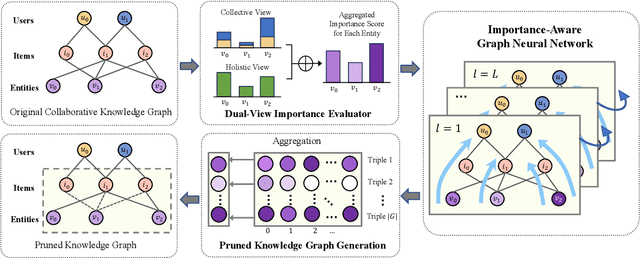
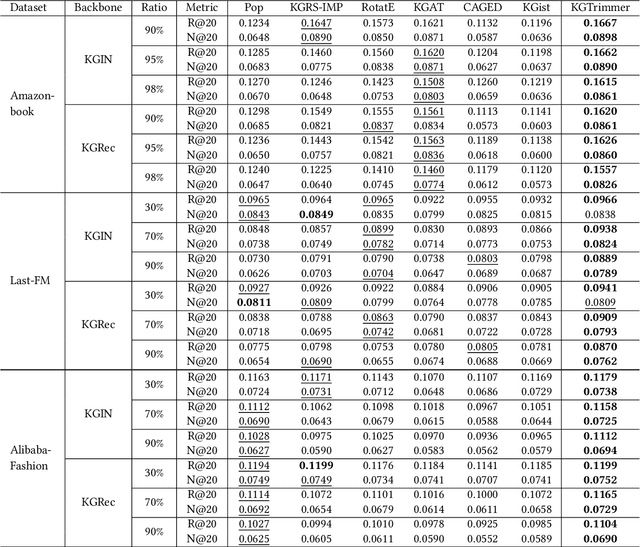
Abstract:Recent years have witnessed the prosperity of knowledge graph based recommendation system (KGRS), which enriches the representation of users, items, and entities by structural knowledge with striking improvement. Nevertheless, its unaffordable computational cost still limits researchers from exploring more sophisticated models. We observe that the bottleneck for training efficiency arises from the knowledge graph, which is plagued by the well-known issue of knowledge explosion. Recently, some works have attempted to slim the inflated KG via summarization techniques. However, these summarized nodes may ignore the collaborative signals and deviate from the facts that nodes in knowledge graph represent symbolic abstractions of entities from the real-world. To this end, in this paper, we propose a novel approach called KGTrimmer for knowledge graph pruning tailored for recommendation, to remove the unessential nodes while minimizing performance degradation. Specifically, we design an importance evaluator from a dual-view perspective. For the collective view, we embrace the idea of collective intelligence by extracting community consensus based on abundant collaborative signals, i.e. nodes are considered important if they attract attention of numerous users. For the holistic view, we learn a global mask to identify the valueless nodes from their inherent properties or overall popularity. Next, we build an end-to-end importance-aware graph neural network, which injects filtered knowledge to enhance the distillation of valuable user-item collaborative signals. Ultimately, we generate a pruned knowledge graph with lightweight, stable, and robust properties to facilitate the following-up recommendation task. Extensive experiments are conducted on three publicly available datasets to prove the effectiveness and generalization ability of KGTrimmer.
DynLLM: When Large Language Models Meet Dynamic Graph Recommendation
May 13, 2024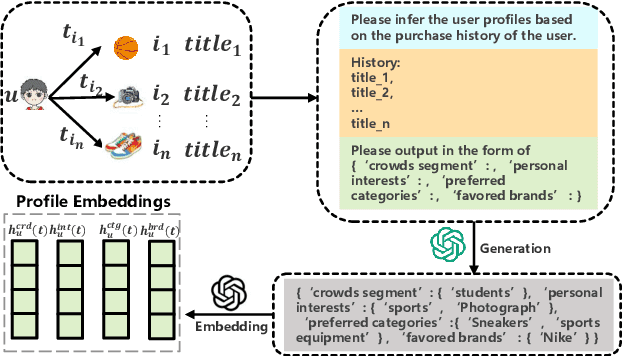
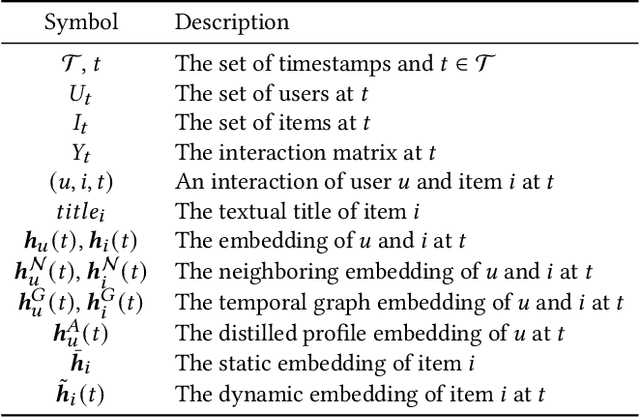
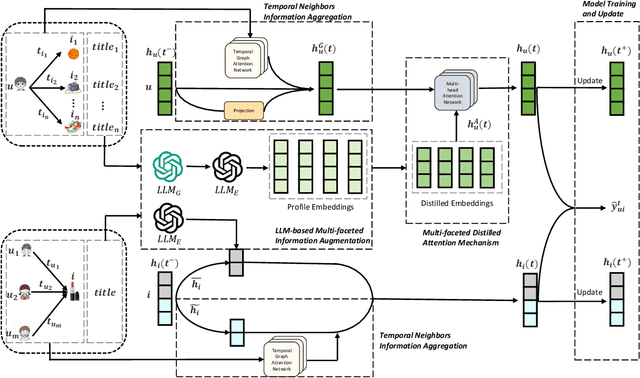
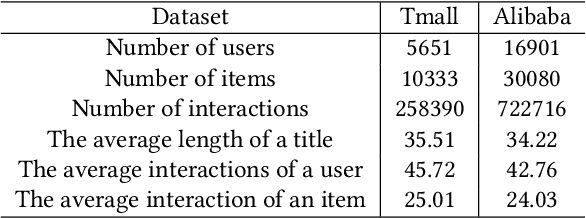
Abstract:Last year has witnessed the considerable interest of Large Language Models (LLMs) for their potential applications in recommender systems, which may mitigate the persistent issue of data sparsity. Though large efforts have been made for user-item graph augmentation with better graph-based recommendation performance, they may fail to deal with the dynamic graph recommendation task, which involves both structural and temporal graph dynamics with inherent complexity in processing time-evolving data. To bridge this gap, in this paper, we propose a novel framework, called DynLLM, to deal with the dynamic graph recommendation task with LLMs. Specifically, DynLLM harnesses the power of LLMs to generate multi-faceted user profiles based on the rich textual features of historical purchase records, including crowd segments, personal interests, preferred categories, and favored brands, which in turn supplement and enrich the underlying relationships between users and items. Along this line, to fuse the multi-faceted profiles with temporal graph embedding, we engage LLMs to derive corresponding profile embeddings, and further employ a distilled attention mechanism to refine the LLM-generated profile embeddings for alleviating noisy signals, while also assessing and adjusting the relevance of each distilled facet embedding for seamless integration with temporal graph embedding from continuous time dynamic graphs (CTDGs). Extensive experiments on two real e-commerce datasets have validated the superior improvements of DynLLM over a wide range of state-of-the-art baseline methods.
BezierFormer: A Unified Architecture for 2D and 3D Lane Detection
Apr 25, 2024Abstract:Lane detection has made significant progress in recent years, but there is not a unified architecture for its two sub-tasks: 2D lane detection and 3D lane detection. To fill this gap, we introduce B\'{e}zierFormer, a unified 2D and 3D lane detection architecture based on B\'{e}zier curve lane representation. B\'{e}zierFormer formulate queries as B\'{e}zier control points and incorporate a novel B\'{e}zier curve attention mechanism. This attention mechanism enables comprehensive and accurate feature extraction for slender lane curves via sampling and fusing multiple reference points on each curve. In addition, we propose a novel Chamfer IoU-based loss which is more suitable for the B\'{e}zier control points regression. The state-of-the-art performance of B\'{e}zierFormer on widely-used 2D and 3D lane detection benchmarks verifies its effectiveness and suggests the worthiness of further exploration.
 Add to Chrome
Add to Chrome Add to Firefox
Add to Firefox Add to Edge
Add to Edge